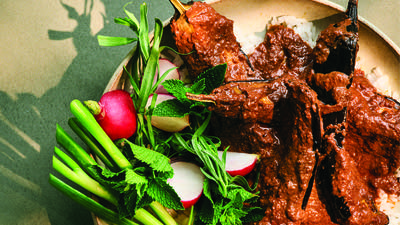
What is it with the snobbery of wine vintage charts? Their Italian sections often show only Tuscany and the Piedmont. Talk about insulting an entire country. Wines worth trying come from every single one of Italy's regions.
For instance, the island of Sicily is in the middle of a winemaking renaissance. New wines are coming from ancient sources. New York chef Melissa Daka, owner of Eolo and Pastai, says wines from Sicily's Mount Etna are "intense just like the fireworks of the lava that spits out of the volcano."
Lynne Rossetto Kasper: The wines of Mount Etna, what are they about?
 Melissa Daka
Photo: Lou Manna
Melissa Daka
Photo: Lou Manna
Melissa Daka: There's a very large mountain -- a volcano -- and there are several vineyards on that volcano from low altitudes to high altitudes. The wines change very much depending where they're located, at what altitude and at what exposure to the sun and to the sea.
But they're very intense wines. They're intense just like the fireworks of the lava that spits out of the volcano. They have deep mineral flavors to them. They have notes of berries, of spiciness and they're very food friendly.
LRK: Are they mainly reds, or are they mainly whites?
MD: There are both.
There's the Etna Rosso; the winemaking laws have them with 80 percent nerello mascalese grape. There are also the whites made mainly with carricante grape. Then there are sparkling wines made with those grapes. There are rosés. There are some that I call super Etna Rossos, which would be anything that's not grown with those grapes on the mountain (which, therefore, do not get a DOC designation), but that are some fabulous wines as well.
LRK: What is the taste of this red grape?
MD: The taste is a deep, rich, very mineral-rich wine that has a smokiness to it almost. It's growing on volcanic, ashy soil, and the flavors of the minerals that are in that soil come through in a surprising way. If you take the soil and actually smell it, and then do the same with the wine, there are notes of the minerals that come through that you can smell on both of them, both on the soil and in the wine.
Also, some of the wines have beautiful notes of violets and roses, while others have deeper scents of dark berries or fresh-crushed berries or plums. But all of them tend to have a smoky minerality to them that tends to be quite elegant. I've yet to taste a wine from Etna that I wouldn't characterize as an elegant wine.
LRK: There's also the main white grape.
MD: Carricante, that's the main white grape that's going into the Etna Bianco. There are a few others that grow on the mountain, but the Etna Biancos are known for their carricante.
Just like many whites that are grown at high altitude, there's a lot of green apple on the nose. There's a tartness to them, and they have a very strong acidic backbone. They actually age very well. They also have notes of white flowers, of honey, and again the strong mineral content of the soil comes through on the whites in a very pleasant way.
Melissa Daka's Etna wine picks
MD: For a white, I would suggest Planeta's Carricante.
For reds, I would look for Benanti's Rosso di Verzella or Girolamo Russo's wines. Murgo has an entry-level Etna Rosso that you can find for about $12. But there are so many producers, and it's very hard to limit them down to a few.
For the price range, you can find anywhere from $12 all the way up to about the $90-100 range. But a safe bet -- if you're not sure of what producer to buy -- the $20-$30 range has some excellent wines.
Try any wines from these producers that are labeled as Etna Bianco, Etna Bianco Superiore or Etna Rosso:
Benanti
Terre Nere
Passopisciaro
Tenuta di Fessina
Girolamo Russo
Firriato
Murgo
Graci
Biondi
Cottanera
Pietradolce
Vivera
Destro
Planeta
I Vigneri
Before you go...
Each week, The Splendid Table brings you stories that expand your world view, inspire you to try something new, and show how food connects us all. We rely on your generous support. For as little as $5 a month, you can have a lasting impact on The Splendid Table. And, when you donate, you’ll join a community of like-minded individuals who love good food, good conversation, and kitchen companionship. Show your love for The Splendid Table with a gift today.
Thank you for your support.
Donate today for as little as $5.00 a month. Your gift only takes a few minutes and has a lasting impact on The Splendid Table and you'll be welcomed into The Splendid Table Co-op.




